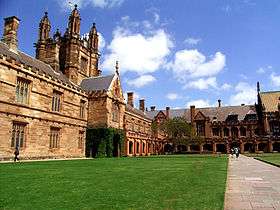The University of Sydney Nano Institute
The University of Sydney Nano Institute (Sydney Nano) is a flagship multidisciplinary research institute at the University of Sydney in Camperdown, Sydney, Australia, focused on transforming our economy, society and everyday life through multidisciplinary research in nanoscale science and technology. It is one of ten multidisciplinary research institutes at the University of Sydney including the Charles Perkins Centre and the Brain and Mind Centre.
| Established | March 2016 |
|---|---|
| Faculty | University of Sydney |
| Formerly called | Australian Institute for Nanoscale Science and Technology (AINST) |
| Location | Sydney, Australia |
| Website | http://sydney.edu.au/nano |
Location and facilities
Sydney Nano is headquartered at the Sydney Nanoscience Hub, a purpose-built facility for nanoscience research completed in 2015 and located on the University's Camperdown/Darlington campus. Sydney Nano's research is also conducted in other science, engineering and medical facilities across the University.
History
Originally launched in April 2016[1] as the Australian Institute for Nanoscale Science and Technology (AINST), the Institute was renamed The University of Sydney Nano Institute in November 2017.[2][3]
In July 2017 the University of Sydney announced a multi-year partnership with Microsoft to conduct research into quantum computing and the official establishment of Microsoft Quantum – Sydney at the Sydney Nanoscience Hub.[4][5][6]
In March 2018 the New South Wales Government provided a A$500,000 grant[7] to set up the Sydney Quantum Academy to strengthen postgraduate research and training in Sydney in the race to build a quantum computer. The Academy will be led by the University of Sydney in partnership with Macquarie University, the University of New South Wales and the University of Technology, Sydney.
Leadership
Director
Sydney Nano was jointly led by three interim directors – Professor Thomas Maschmeyer FAA FTSE, Professor Simon Ringer and Professor Zdenka Kuncic – who oversaw the launch period of the Institute from March 2016.
Professor Susan Pond AM was appointed to the directorship in February 2017 for a period of 12 months. Professor Pond is a senior leader in business and academia and recognised for her significant national and international contributions to medicine, science and technology. Awards include Member of the Order of Australia (1994), Doctor of Medicine honoris causa from the University of Queensland and the Centenary Medal. In 2013 she was named as one of Australia's Top 100 Women of Influence by The Australian Financial Review and Westpac. Professor Pond is a Fellow of the Royal Australasian College of Physicians, the Australian Academy of Technological Sciences and Engineering, the Australian Academy of Health and Medical Sciences and the Australian Institute of Company Directors.
Professor Ben Eggleton is the current director. He was appointed in May 2018.[8]
Research theme leaders
- Energy and Environment: Associate Professor Cara Wrigley
- Health and Medicine: Associate Professor Wojciech Chrzanowski
- Communications, Computing and Security: Dr Ralph Holz
Research domain leaders
- Quantum Science: Dr Ivan Kassal
- Nanophotonics: Associate Professor Stefano Palomba
- Materials on the Nanoscale: Associate Professor Jun Huang
- Molecular Nanoscience: Associate Professor Chiara Neto
Research themes and capabilities
Sydney Nano's research is grouped into three broad themes that directly address significant global challenges in the 21st Century, and four domains of research expertise.
Research themes
- Energy and environment
- Health and medicine
- Communications, computing and security
Domains of research
- Quantum science
- Nanophotonics
- Materials on the nanoscale
- Molecular nanoscience
References
- Strom, Marcus (8 March 2016). "Sydney University to open Nanoscience Hub for the quantum technologies of the future". The Sydney Morning Herald. Archived from the original on 20 March 2018. Retrieved 20 March 2018.
- "High Wired Update: Nano by name and by nature". www.theaustralian.com.au. Retrieved 20 March 2018.
- "Small changes mean big opportunities: AINST becomes Sydney Nano". The University of Sydney. Archived from the original on 20 March 2018. Retrieved 27 November 2017.
- "Microsoft and University of Sydney forge quantum partnership". The University of Sydney. Archived from the original on 2 September 2017. Retrieved 27 November 2017.
- "USYD and Microsoft sign global quantum computing partnership – PACE". PACE. 25 July 2017. Archived from the original on 26 July 2017. Retrieved 20 March 2018.
- "Sydney nanoscience centre opens doors for Microsoft to lead 'computer arms race'". ABC News. 20 April 2016. Archived from the original on 21 March 2017. Retrieved 20 March 2018.
- Pash, Chris (7 March 2018). "Sydney just entered the race to build the world's first quantum computer". Business Insider Australia. Archived from the original on 20 March 2018. Retrieved 20 March 2018.
- "Professor Ben Eggleton appointed director of Sydney Nano". The University of Sydney. 10 April 2018. Retrieved 7 November 2018.
